 |
 |
 |
| |
Higher rate of HAART reinitiation among HIV-HBV coinfected patients in the episodic arm of the SMART study
|
| |
| |
Reported by Jules Levin
4th IAS Conference, July 22-25, 2007, Sydney, Australia
Presented by Greg Dore, Australia.
Dore G.1, Soriano V.2, Neuhaus J.3, Peters L.4, Puoti M.5, Rockstroh J.6, Klein M.7, Tedaldi E.8, Mocroft A.9, Clotet B.10, Lundgren J.4, The SMART study group and INSIGHT
1National Centre in HIV Epidemiology and Clinical Research, University of New South Wales, Sydney, Australia, 2Service of Infectious Diseases, Hospital Carlos III, Madrid, Spain, 3School of Public Health, University of Minnesota, Minnesota, United States, 4Copenhagen HIV Programme, Hvidovre University Hospital, Copenhagen, Denmark, 5Institute of Infectious and Tropical Diseases, Brescia, Italy, 6Medizinische Universitaetsklinik, Bonn, Germany, 7Montreal Chest Institute, Royal Victoria Hospital, Montreal, Canada, 8Temple University School of Medicine, Philadelphia, United States, 9Royal Free and University College Medical School, London, United Kingdom, 10Hospital Universitari Germans Trias I Pujol, Badalona, Spain
AUTHOR Conclusions / discussion
HIV-HBV coinfected patients have a higher rate of ART reinitiation (not seen in HIV-HCV coinfected)
Higher ART reinitiation due largely to faster decline to CD4 <250
Hepatic flare or reinitiation at higher CD4 counts does not explain higher rate
Impact of HBV-DNA rebound on ART reinitiation will be explored
Potential insights into HIV-HBV immunopathogenesis
ABSTRACT
Objectives: To examine rates of antiretroviral therapy (ART) reinitiation within the episodic therapy (drug conservation, DC) group of the SMART study according to baseline hepatitis status.
Methods: Time to ART reinitiation was examined by Kaplan Meier analysis among patients randomized to the DC arm of SMART in three groupings:
1) hepatitis B virus (HBV) (HBsAg+);
2) hepatitis C virus (HCV) (anti-HCV Ab+); and
3) non-HBV/HCV. Factors associated with ART initiation were examined using Cox proportional hazard models adjusting for age, gender, prior AIDS, baseline and nadir CD4 count and HIV viral load.
Results: Data was available on 2669 patients within the SMART DC arm with a mean follow-up of 16 months. Baseline characteristics were similar although median baseline and nadir CD4 counts were lowest in the HBV group (Table). Reasons for ART reinitiation were similar including CD4 count <250/mm3. Median time to ART reinitiation was shortest in the HBV group. Multivariate factors associated with ART reinitiation were HBsAg+ (hazard ratio=1.67, 95% confidence intervals 1.22-2.29), baseline CD4 count (per 100cells/mm3 higher): 0.87(0.85-0.90), nadir CD4 count (per 100cells/mm3 higher): 0.67(0.63-0.71)), age (per 10y older): 1.14(1.07 - 1.21), prior AIDS 1.41(1.23-1.61), baseline HIV-RNA<400copies/mL 1.19(1.04 - 1.37) and highest recorded log10 HIV RNA (per 1 log higher): 1.19(1.11 - 1.28).
Conclusions: HBV/HIV-coinfected patients had a higher rate of ART reinitiation within the episodic therapy arm of SMART. Hepatic flares or reinitiation at higher CD4 counts does not explain this finding, suggesting that the drop in CD4 count is more rapid for HBV coinfected patients with uncontrolled HBV replication.
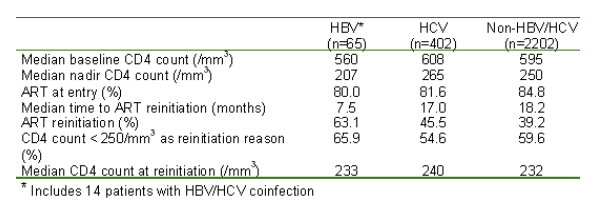
SMART: ART reinitiation by hepatitis status
Background
HBV (5 - 10%) and HCV (10 - 30%) are common coinfections among HIV infected populations
HIV associated with higher HBV DNA and HCV RNA levels
Increased liver disease mortality in HIV-HCV and HIV-HBV compared to monoinfected populations, even in era of HAART
Increasing use of dual HIV/HBV active agents in setting of HIV-HBV coinfection
SMART study presents an ideal opportunity to examine HIV-hepatitis
immunopathogenesis
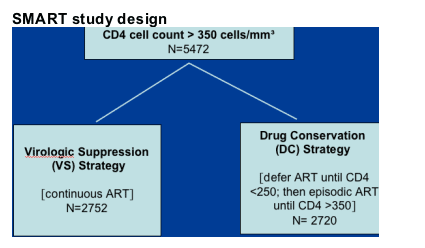
SMART: ART reinitiation by hepatitis status
SMART study
Median follow-up 16 months
Primary endpoint: opportunistic disease or death higher in DC (3.3/100 py) than VS (1.3/100 py) group (HR=2.6, 1.9 - 3.7).
El-Sadr WM et al, N Engl J Med 2006; 355(22):2283-2296
SMART eligibility allowed HBsAg+ and anti-HCV+, had no ALT-based exclusion, but recommended that subjects requiring continued ART for management of hepatitis should not be enrolled.
HBsAg 2.0%; anti-HCV 14.6%; HBV/HCV 0.3%
Objective
To examine rates of ART reinitiation within the DC (episodic) group of the SMART study according to baseline hepatitis status
Sub-groups: 1) HBV; 2) HCV; 3) non-HBV/HCV
ART reinitiation examined by Kaplan-Meier analysis
Cox proportional hazard models adjusting for age, gender, prior AIDS, baseline and nadir CD4 count, and HIV viral load
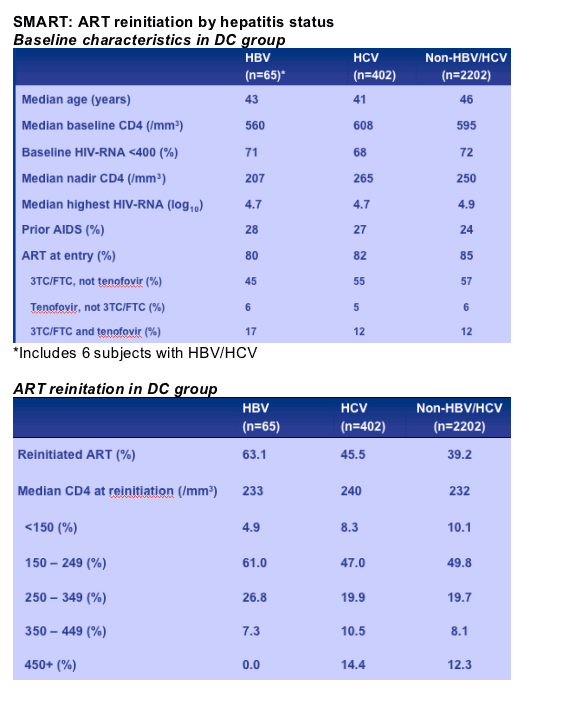
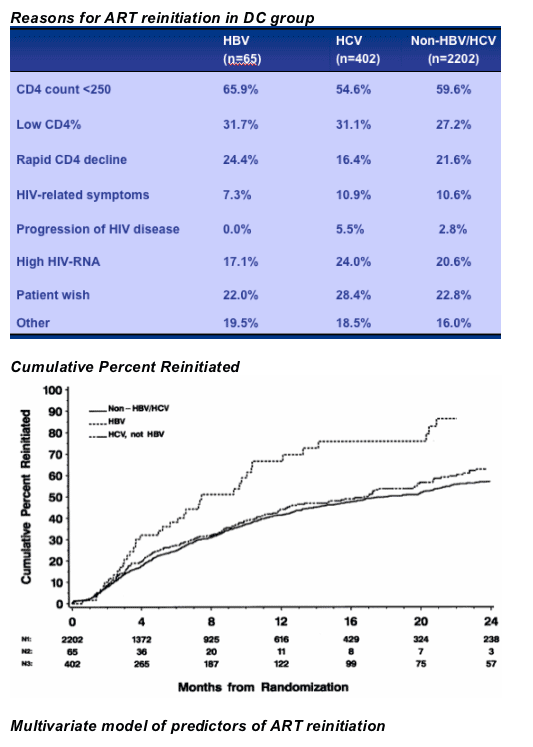
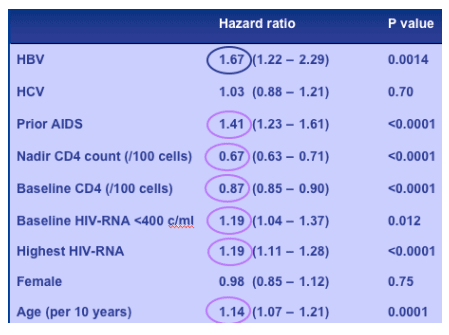
|
| |
|
 |
 |
|
|